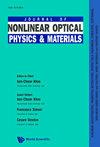无自旋金属中的极化子——一个变分解
IF 2.3
4区 物理与天体物理
Q2 OPTICS
引用次数: 1
摘要
我们提出了一种简单的变分解来计算具有强电子-声子耦合的无自旋金属晶格模型中的单粒子谱函数。它基于对单极化子的动量平均变分近似的推广,并结合了系统中其他费米子被锁定在惰性费米海中的假设。我们期望在特征声子频率不太小的情况下,该方法对于费米能量小的金属中的费米子添加谱函数(几乎是空带)和费米能量大的金属中的费米子去除谱函数(几乎是全带)是准确的。这两个区域都远离米格达尔定理适用的区域,因此我们的结果为参数空间中大部分未探索部分的极化行为提供了新的见解。在这里,我们展示了一维荷斯泰因耦合的结果,并提出了测量其精度的方法,但最终这将需要通过数值计算来验证。这种变分方法可以直接推广到更高的维度和其他形式的电子-声子耦合。本文章由计算机程序翻译,如有差异,请以英文原文为准。
Polarons in spinless metals—a variational solution
We propose a simple variational solution for calculating one-particle spectral functions in lattice models of spinless metals with strong electron-phonon coupling. It is based on a generalization of the Momentum Average variational approximation for single polarons, combined with the assumption that the other fermions in the system are locked into an inert Fermi sea. We expect the method to be accurate for fermion addition spectral functions in metals with a small Fermi energy (nearly empty band), and for fermion removal spectral functions in metals with a large Fermi energy (nearly full band), provided that the characteristic phonon frequency is not too small. Both these regions are far from the region where the Migdal theorem holds, thus our results offer new insights into polaronic behavior in a largely unexplored part of the parameter space. Here, we show results for the Holstein coupling in one-dimension and present ways to gauge their accuracy, but ultimately this will need to be verified against numerical calculations. This variational method can be extended straightforwardly to higher dimensions and other forms of electron-phonon coupling.
求助全文
通过发布文献求助,成功后即可免费获取论文全文。
去求助
来源期刊
CiteScore
3.00
自引率
48.10%
发文量
53
审稿时长
3 months
期刊介绍:
This journal is devoted to the rapidly advancing research and development in the field of nonlinear interactions of light with matter. Topics of interest include, but are not limited to, nonlinear optical materials, metamaterials and plasmonics, nano-photonic structures, stimulated scatterings, harmonic generations, wave mixing, real time holography, guided waves and solitons, bistabilities, instabilities and nonlinear dynamics, and their applications in laser and coherent lightwave amplification, guiding, switching, modulation, communication and information processing. Original papers, comprehensive reviews and rapid communications reporting original theories and observations are sought for in these and related areas. This journal will also publish proceedings of important international meetings and workshops. It is intended for graduate students, scientists and researchers in academic, industrial and government research institutions.

 求助内容:
求助内容: 应助结果提醒方式:
应助结果提醒方式:


